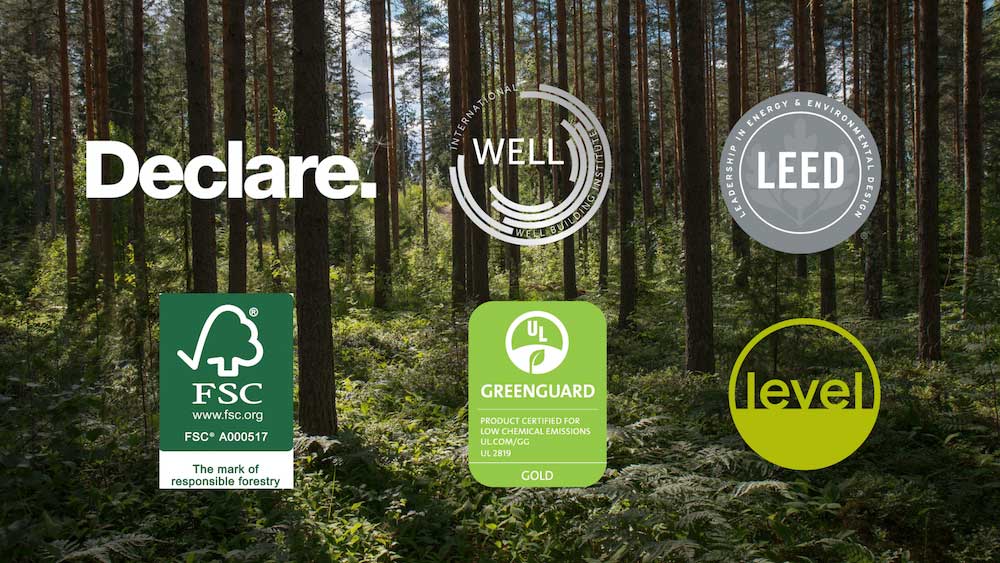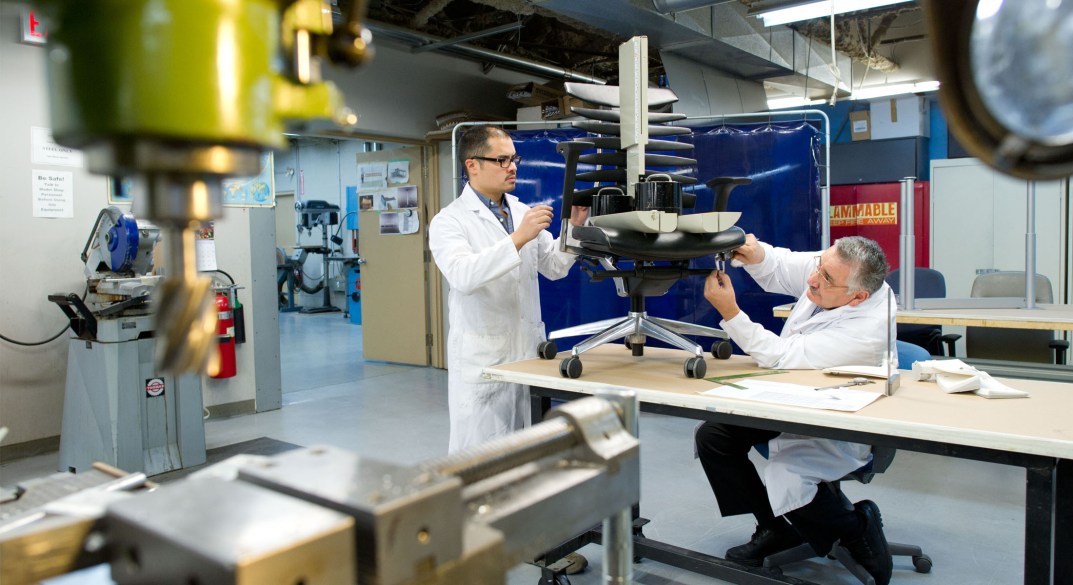Details
Furniture Eco Labels & How to Pick One?
16 May 2021
Climate Change is a reality and there is an overwhelming need to make better choices. Who would have ever guessed that choice was one of the problems? A key finding from 2019’s research by LTD in the region suggests that the end customer doesn’t even know where to begin when it comes to the number of certifications available.
Here are just some of the certifications to contend with while picking furniture, let alone fabrics, ceilings, flooring and other equipment!
- GREENGUARD
- FSC
- SAN
- EPD
- HPD
- DECLARE
- EPD
- Indoor Air Advantage
- Level
- Cradle to Cradle
Step 1: Decide if your Workspace is going to be certified
This is important as it can take away some of the choice up front, it is however the most expensive of the options discussed.
- LEED (Leadership in Energy & Environmental Design) circa 2000
- LEED’s focus has been on looking at the long term health of the planet and protecting the resources used for future generations.
- The WELL Building Standard circa 2016
- WELL’s focus has been on measuring, certifying & monitoring the performance of building features that impact health and well-being.
The two options above are the most popular in the region and have countless resources and experts to pursue them. Other certifications not covered in this article are:
- Estidama - United Arab Emirates
- Three Star - China
- Green Star - Australia
- BREEAM - United Kingdom
- Living Building Challenge - United States
LEED & WELL both have stringent requirements and consultants to help you gather the points required to get certified
- Certified (LEED)
- Silver (LEED / WELL)
- Gold (LEED / WELL)
- Platinum (LEED / WELL)
The effect that furniture has on either of the certifications mentioned above accounts for 14% of the points for LEED v4 & 10% of the points for WELL
Step 2: I’m not certifying my facility but I want to choose responsibly
This is definitely the less expensive option as you are now only focused on the 14% (mentioned above) rather than the entire facility. There are two options, you can either pick a multi attributed certification or a single attributed certification:
- Single Attributed Labels
- GREENGUARD
- FSC
- SAN
- Indoor Air Advantage
- Multi attributed Labels
- Level
- Cradle to Cradle
- Transparency Protocols
- EPD
- HPD
- DECLARE
Single Attributed Labels are focused on very specific achievements:
Greenguard certified by UL & Indoor Air Advantage certified by SCS Global (add links to each of these names) each focus on measuring the amount of toxins your product emits after the product is produced. These toxins include formaldehyde & other chemicals that are present in paints, sealants & glues. These toxins can be odourless and extremely harmful for your wellbeing.
FSC (Forest Stewardship Council)
A certification that ensures the product you have is sourced from sustainably managed forests and the chain of custody runs right across the supply chain till the completion of manufacturing. This is a key label to look out for if you are particularly concerned about the rate of deforestation in the world.
SAN (Sustainable Agriculture Standard) covers biobased materials to ensure they are farmed in a manner that is climate smart, deforestation free and pollinator friendly. SAN is by far the newest certification of the Single Attributed ones with its launch in 2017
If you are particularly passionate about one or all of the above, you can carefully pick your products or manufacturers that have attained these certifications.
Multi Attributed Labels have a matrix of requirements that need to be achieved.
These certifications can cover not just the product but the facility it is produced in and the manufacturer’s social responsibility to its people, community and the product’s end of life options.
Level certification by BIFMA covers these elements:
- Materials
- Energy & Atmosphere
- Human & Ecosystem Health
- Social Responsibility
While considering Product, Facility & Organization across the four elements. The number of points gained by the product allows it to be rated between Level 1, 2 & 3 (Level 3 being the highest achievable certification).
This multi attributed certification covers five elements:
- Material health
- Material reutilization
- Renewable energy
- Carbon management
- Water stewardship
- Social fairness.
Simply put this covers the raw materials, manufacturing process and the organization that produces these products. Like LEVEL above, all products are not equal and are ranked in a tier format based on the points they achieve and can be seen as ranked. Unlike LEVEL, you can only achieve Silver if all the requirements in Basic & Bronze are achieved
- Basic
- Bronze
- Silver
- Gold
- Platinum (the highest rank)
Transparency Protocols
Transparency protocols focus on the ingredients of the product, its supply chain, recyclable content, chemical composition and its end of life use. They don’t evaluate the product but present the information similar to a nutrition label on a food item and leave the consumer to come to their own conclusions.
Declare (International Living Future Institute)
Declare is an ingredients initiative for building products that is designed to shape a greener, healthier environment for construction workers, business employees, and customers alike.
Declared products disclose 100% of product ingredients plus residuals present at or above 100ppm (0.01%) in the final product, but contain one or more Red List chemicals.
HPD's (Health Product Declaration)
HPD provides a chemical inventory of a building product and characterizes the level of concern about each ingredient. HPD’s can be created by a product manufacturer, or can be created by a third party consultant.
EPD’s (Environmental Product Declaration)
An EPD is a declaration that considers the full Life Cycle Assessment of a product. It’s based on the standard ISO 14025 and can be verified by a third party (Type 1) or self declared (Type 2)
Eg: Teknion District Workstation EPD
What is the final verdict?
Each of the certifications above gives you a deeper understanding of the efforts manufacturers go through to not just develop a more environmentally sustainable product but behave in a socially responsible way too.
Going for Step 1 (Project Certification) is a larger undertaking, however provides a more holistic approach to a healthy & environmentally sustainable space.
If you do choose Step 2: Picking a multi attributed label like Level is likely to be a better choice, however if you do choose a single attributed label, FSC & Indoor Air Advantage are worth considering in your product choices.
As a provider of workspace solutions, The Total Office helps elevate the work experience of its customers by addressing collaboration, acoustics, environmental sustainability and well being at the design stage using globally recognized products and tools. This enables its customers to raise their productivity in the workspace laying a foundation for innovation and a sound work culture. The Total Office is Headquartered in Dubai, UAE serving the country and the wider Middle East region. For more information visit: www.thetotaloffice.com





